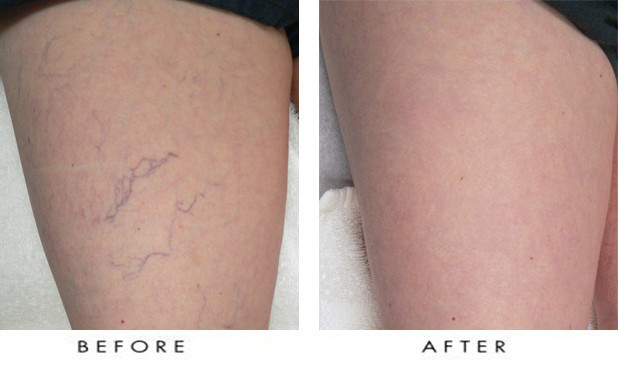Laser Spider Veins Treatment
Laser Spider Veins Treatment is a minimally invasive procedure that can reduce the appearance of spider veins. Spider veins, also known as telangiectasias, are small, thin blood vessels visible beneath the skin. They appear most commonly on the face and legs, and may look like a series of lines, tree branches or spider webs. Spider veins are caused by a variety of factors, including heredity, pregnancy and weight gain. Some people experience painful symptoms such as aching, burning, swelling and cramping from spider veins, while others are simply bothered by their appearance.
Treatment for spider veins can be done through traditional sclerotherapy or through more advanced and minimally invasive laser procedures. Laser treatment for spider veins offers patients:
- Fewer side effects
- Less trauma
- Shorter treatment time
- Shorter recovery time
- Minimal downtime
There are several different types of laser treatment available, including endovenous laser treatment, or EVLT, which treats large veins by passing a laser fiber through a catheter directly into the vein. Veins just under the surface of the skin can be treated with a simpler laser procedure over the course of several treatment sessions. After performing a physical examination and going over a patient’s medical history and general health, the doctor will decide which procedure is best for each individual patient.
What Are Spider Veins?
Spider veins are veins in which the valves have stopped functioning properly. When the valves of a vein are working correctly, they keep blood flowing in one direction. When they become damaged, they allow blood to flow backwards and pool, causing the walls of the vein to distend and enlarge. This is called venous reflux. When smaller, more superficial veins are involved, a web of red or blue thin branches appear on the surface of the skin, usually on the legs or face. These are referred to as spider veins.

What Is The Difference Between Spider Veins And Varicose Veins?
Spider veins, although they result from the same type of vascular malfunction as varicose veins, are much less serious. Spider veins are a superficial manifestation of the problem. When veins become varicose, their walls have thinned considerably and blood has pooled in them so that they appear as palpable dark cords on the surface of the skin.
What Are The Risk Factors For Spider Veins?
The causes of spider are not completely known, but many identifiable factors put an individual at risk. Risk factors for spider veins include:
- Increasing age over 50
- Smoking
- Family history of the disease
- Prolonged sitting or standing
- Hormonal changes
- Pregnancy
- Obesity
- Lack of exercise
- Sun exposure
Since hormonal changes increase the risk of developing spider veins there is a higher risk of developing the problem during puberty, menopause, pregnancy and while taking birth control medication. Since extra weight puts stress on veins, pregnancy involves a double risk. Because women go through greater hormonal fluctuations and may go through pregnancy, more women than men develop spider veins.
Can Spider Veins Be Dangerous?
Not usually. In and of themselves, varicose veins are not usually dangerous, but left untreated they may develop into varicose veins which are a more serious medical condition. Varicose veins may result in pain, fatigue, or inflammation of the skin and may be evidence of arteriosclerosis or clotting difficulties.
How Are Spider Veins Treated?
As with so many other medical conditions, weight loss and regular exercise are helpful in treating spider veins and particularly in keeping them from developing into varicose veins. Wearing compression stockings and avoiding leg crossing and sitting or standing for prolonged periods may also be useful.
For patients who want spider veins removed for cosmetic reasons, the two most frequently employed methods are sclerotherapy and laser ablation. Both are minimally invasive, outpatient procedures, providing excellent results.
Can Spider Veins Be Prevented?
Possibly. Since there is a hereditary component to the development of spider veins, they cannot be prevented in all cases. Keeping to a healthy diet and normal weight, applying sunscreen, exercising regularly, and avoiding long periods of sitting or standing may prevent the development of spider veins and will certainly contribute to good vascular health.
To schedule an appointment, give us a call at 803.851.3459 during business hours! Monday 9-5, Tuesday through Thursday 9-6, Friday 9-2
To order online and view our prices, visit our Online Store!



